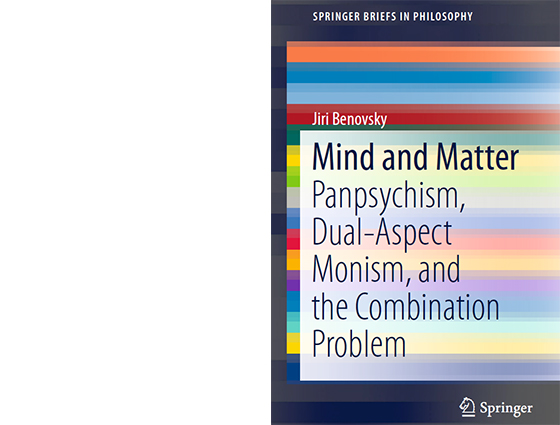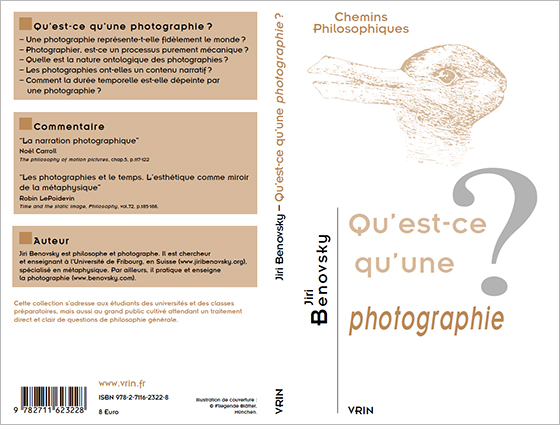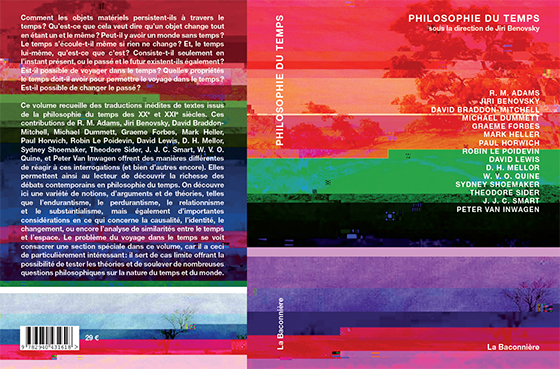Ouvrages académiques

Eliminativism, objects, and persons.
The virtues of non-existence.
Routledge
In this book, Jiri Benovsky defends the view that he doesn't exist. He also defends the view that this book itself doesn't exist. But this did not prevent him to write the book, and although in Benovsky's view you don't exist either, this does not prevent you to read it.
Benovsky defends a brand of non-exceptionalist eliminativism. Some eliminativists, typically focusing on ordinary material objects such as chairs and hammers, make exceptions, for instance for blue whales (that is, living beings) or for persons (that is, conscious organisms). Benovsky takes one by one all types of allegedly existing objects like chairs, whales, and persons and shows that from the metaphysical point of view they are more trouble than they are worth - we are much better off without them. He thus defends an eliminativist view about ordinary objects as well as the 'no-Self' view, where he explores connections between metaphysics, phenomenology, and Buddhist thought. He then also considers the case of aesthetic objects, focusing on musical works and photographs, and shows that the claim of their non-existence solves the many problems that arise when one tries to find an appropriate ontological category for them, and that such an eliminativist view is more natural than what we might have thought. The arguments provided here are always topic-specific: each type of entity is given its own type of treatment, thus proving a varied and solid foundation for a generalized, non-exceptionalist, full-blown eliminativist worldview.

Meta-metaphysics.
On metaphysical equivalence, primitiveness, and theory choice.
Springer
Metaphysical theories are beautiful. I mean it literally. At the end of this book, I defend the view that metaphysical theories possess aesthetic properties and that these play a crucial role when it comes to theory evaluation and theory choice.
But this is the end of a long journey - a journey that is perhaps more important than the destination. Before we get there, the philosophical path I propose to follow starts with three discussions of metaphysical equivalence. I argue that there are cases of metaphysical equivalence, cases of partial metaphysical equivalence, as well as interesting cases of theories that are not equivalent. Thus, claims of metaphysical equivalence can only be raised locally. My slogan is : the best way to do meta-metaphysics is to do first-level metaphysics.
To do this work, I focus on the nature of primitives and on the role they play in each of the theories involved. I emphasize the utmost importance of primitives in the construction of metaphysical theories and in the subsequent evaluation of them.
I then raise the simple but complicated question: how to make a choice between competing metaphysical theories? If two theories are equivalent, then perhaps we do not need to make a choice. But what about all the other cases of non-equivalent "equally good" theories? I use some of the theories discussed in the first part of the book as examples and I examine some traditional meta-theoretical criteria for theory choice (various kinds of simplicity, compatibility with physics, compatibility with intuitions, explanatory power, internal consistency,...) only to show that they do not allow us to make a choice.
But if the standard meta-theoretical criteria cannot help us in deciding between competing non-equivalent metaphysical theories, how then shall we make that choice? This is where I argue that metaphysical theories possess aesthetic properties - grounded in non-aesthetic properties - and that these play a crucial role in theory choice and evaluation. This view, as well as all the meta-metaphysical considerations discussed throughout the book, then naturally lead me to a form of anti-realism, and at the end of the journey I offer reasons to think better of the kind of anti-realist view I propose to embrace.

The Limits of Art.
On borderline cases of artworks and their aesthetic properties.
Springer
This book is about exploring interesting borderline cases of art. Jiri Benovsky discusses the cases of gustatory and olfactory artworks (focusing on food), proprioceptive artworks (dance, martial arts, and rock climbing qua proprioceptive experiences), intellectual artworks (philosophical and scientific theories), as well as the vague limits between painting and photography. This book is then about what counts as art and what does not, as well as about the nature of these limits. Overall, Benovsky defends a very inclusive view, 'extending' the limits of art, and he argues for its virtues. Some of the limits discussed concern our senses (our different perceptual modalities), some concern vagueness and fuzzy boundaries between different types of works of art, some concern the amount of human intention and intervention in the process of creation of an artwork, and some concern the border between art and science. In these various ways, by understanding better such borderline cases, Benovsky suggests that we get a better grip on an understanding of the nature of art.

Mind and matter.
Panpsychism, dual-aspect monism, and the combination problem.
Springer
In this book, Jiri Benovsky takes a stand for a variant of panpsychism as being the best solution available to the mind-body problem. More exactly, he defends a view that can be labelled 'dual-aspect-pan-proto-psychism'. Panpsychism claims that mentality is ubiquitous to reality, and in combination with dual-aspect monism it claims that anything, from fundamental particles to rocks, trees, and human animals, has two aspects: a physical aspect and a mental aspect. In short, the view is that the nature of reality is 'phental' (physical-mental). But this does not mean, according to the author, that rocks and photons think or have conscious experiences, in the sense in which human animals have experiences. This is where pan-proto-psychism enters the picture as being a better theoretical option, where the mental aspects of fundamental particles, rocks, and trees are not experiential.
Many hard questions arise here. In this book, Benovsky focuses on the combination problem: in short, how do tiny mental aspects of fundamental particles combine to yield macro-phenomenal conscious experiences, such as your complex experience when you enjoy a great gastronomic meal? What makes the question even harder is that the combination problem is not just one problem, but rather a family of various combination issues and worries. Benovsky offers a general strategy to deal with these combination problems and focuses on one in particular namely, the worry concerning the existence of subjects of experience. Indeed, if standard panpsychism were true, we would need an explanation of how tiny micro-subjects combine into a macro-subject like a human person. And if panprotopsychism is true, it has to explain how a subject of experience can arise from proto-micro-mental aspects of reality. Benovsky shows that understanding the nature of subjectivity in terms of the growingly familiar notion of mineness in combination with an eliminativist view of the self, allows us to have a coherent picture, where this type of combination problem is avoided, without throwing the baby out with the bathwater.

Persistence through time, and across possible worlds.
De Gruyter
How do ordinary objects persist through time and across possible worlds ? How do they manage to have their temporal and modal properties ? These are the questions adressed in this book which is a "guided tour of theories of persistence". The book is divided in two parts. In the first, the two traditional accounts of persistence through time (endurantism and perdurantism) are combined with presentism and eternalism to yield four different views, and their variants. The resulting views are then examined in turn, in order to see which combinations are appealing and which are not. It is argued that the 'worm view' variant of eternalist perdurantism is superior to the other alternatives. In the second part of the book, the same strategy is applied to the combinations of views about persistence across possible worlds (trans-world identity, counterpart theory, modal perdurants) and views about the nature of worlds, mainly modal realism and abstractionism. Not only all the traditional and well-known views, but also some more original ones, are examined and their pros and cons are carefully weighted. Here again, it is argued that perdurance seems to be the best strategy available.

Qu‘est-ce qu‘une photographie ?
Editions Vrin
Dans ce livre, il ne s‘agit pas pour moi de donner des conseils ‘pratiques‘ pour faire de la photo, mais plutôt je m‘intéresse de manière théorique à ce que sont les photographies et quelles sont leurs fonctions. Il s‘agit d‘un livre de philosophie de la photographie, qui j‘espère intéressera non seulement les philosophes mais également celles et ceux qui pratiquent la photographie et qui souhaitent réfléchir sur leur art.

Philosophie du temps.
Éditions La Baconnière
Comment les objets matériels persistent-ils à travers le temps ? Qu'est-ce que cela veut dire qu'un objet change tout en étant un et le même ? Peut-il y avoir un monde sans temps ? Le temps s'écoule-t-il même si rien ne change ? Et, le temps lui-même, qu'est-ce que c'est ? Consiste-t-il seulement en l'instant présent, ou le passé et le futur existent-ils également ? Est-il possible de voyager dans le temps ? Quelles propriétés le temps doit-il avoir pour permettre le voyage dans le temps ? Est-il possible de changer le passé ?
Ce volume recueille des traductions inédites de textes issus de la philosophie du temps des XXe et XXIe siècles. Ces contributions de R. M. Adams, Jiri Benovsky, David Braddon-Mitchell, Michael Dummett, Graeme Forbes, Mark Heller, Paul Horwich, Robin Le Poidevin, David Lewis, D. H. Mellor, Sydney Shoemaker, Theodore Sider, J. J. C. Smart, W. V. O. Quine, et Peter Van Inwagen offrent des manières différentes de réagir à ces interrogations (et bien d'autres encore). Elles permettent ainsi au lecteur de découvrir la richesse des débats contemporains en philosophie du temps. On découvre ici une variété de notions, d'arguments et de théories, telles que l'endurantisme, le perdurantisme, le relationnisme et le substantialisme, mais également d'importantes considérations en ce qui concerne la causalité, l'identité, le changement, ou encore l'analyse de similarités entre le temps et l'espace. Le problème du voyage dans le temps se voit consacrer une section spéciale dans ce volume, car il a ceci de particulièrement intéressant : il sert de cas limite offrant la possibilité de tester les théories et de soulever de nombreuses questions philosophiques sur la nature du temps et du monde.

